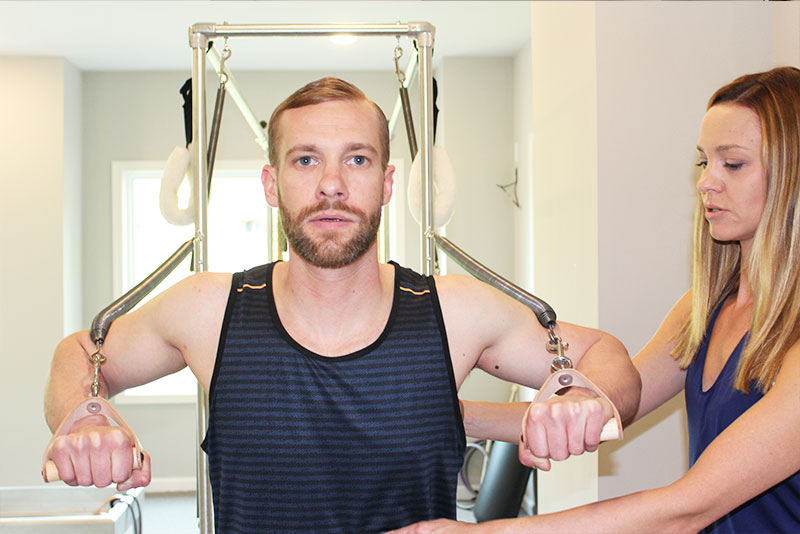Understanding the Principles of Pilates

Pilates has been around for a long time, but its popularity continues to grow as more people learn about its many benefits, such as better balance and flexibility, less back pain, and better posture. If you are new to Pilates, you may not be familiar with the classical techniques that are structured on Pilates principles that can be traced back to Joseph Pilates himself.
How many principles is Pilates based on? Let’s look at the original six principles that are still the backbone of the classical Pilates method today.
Humble Beginnings
Joseph Pilates called it “Contrology,” but today, it is better known by his name. He was a life-long athlete, and he developed this regimen of strengthening principles while held in an internment camp during World War I. After the war, he moved to New York and opened a studio with his wife to teach others his techniques for core strengthening and flexibility building. It became popular with dancers who wanted to prevent injuries, and it has continued to be associated with lithe bodies and lean muscles that define most dancers’ physiques.
A Modern Look
![]() Virtually anyone can begin practicing Pilates, no matter his or her fitness level. Pilates can focus on mat exercises or specialized equipment, but the six Pilates principles are the same regardless of the equipment you use.
Virtually anyone can begin practicing Pilates, no matter his or her fitness level. Pilates can focus on mat exercises or specialized equipment, but the six Pilates principles are the same regardless of the equipment you use.
- Control – Joseph Pilates understood the importance of controlling each movement by being aware of your body; after all, he did call his program “Contrology.” Every aspect of the moves should be controlled for proper form and alignment to reap the benefits of the exercises. Without control, you are more likely to injure yourself.
- Centering – Consider your core itself: your abdominal muscles, lower back, and buttocks. These parts of your torso are your powerhouse, where every movement should originate. They also provide the structure that determines the shape of your body, not just the spine, but also the large muscles that maintain your alignment and support your internal organs.
- Breath – Breathing is involuntary, but just as with your muscles, you can control your breathing patterns while practicing Pilates movements. Deep inhales and exhales allow more oxygen to reach your muscles while focusing on controlling your core. It can be challenging to hold your abdominal muscles in while breathing, but with practice, you may find yourself using Pilates breath when you are off the mat as it becomes almost second nature for you.
- Precision – Precision goes hand in hand with control. Every movement has a purpose and should be performed with intention and care. Pilates is all about quality over quantity, so maintaining proper form is more important to Pilates principles than repetition. The way you hold your arms, the focus you have on contracting your abs, the steady breathing…it all works together to maintain your control and precision.
- Concentration – With all this emphasis on movements and muscles, you might think you are giving your mind a rest, but with Pilates, your brain is as engaged as your body. Your mind is tasked with a lot of responsibility during Pilates exercises, from remembering to hold in your core and breathe to focusing on the precision of movement from beginning to end. It can be almost meditative for some people as they park their other thoughts to focus on their bodies during Pilates.
- Flow – Fluid motion and coordination are hallmarks of Pilates. Flow is where form meets function; with precision and control comes grace and flexibility. There is a softness and lightness to a Pilates workout that you may not see from other forms of fitness, which may be why it appeals to so many people.
A Collective Movement
With these six Pilates principles explained, you now have the knowledge that drives the classical Pilates method. In addition to these principles, here are a few standard exercises that are part of most Pilates mat classes:
- The Hundred
- The Roll Up and Roll Over
- Single Leg Stretch, Double Leg Stretch, One Leg Circles
- Spine Stretch Forward
- Open Leg Rocker
- Swimming
- Planks (see example below)

You can always make modifications to any of these movements to accommodate your strength level or any injury from which you may be healing. While these exercises may not be in every class, they do reflect some of the basic movements that Joseph Pilates created many decades ago.
Join Us
At The Pilates Swan, we dedicate our studio to these six Pilates principles and the classical method that traditional classes follow. We would love to help you discover the strength and mindfulness that you can gain from a regular Pilates practice. Please contact us to learn more about our private and semi-private sessions.

Recent Comments